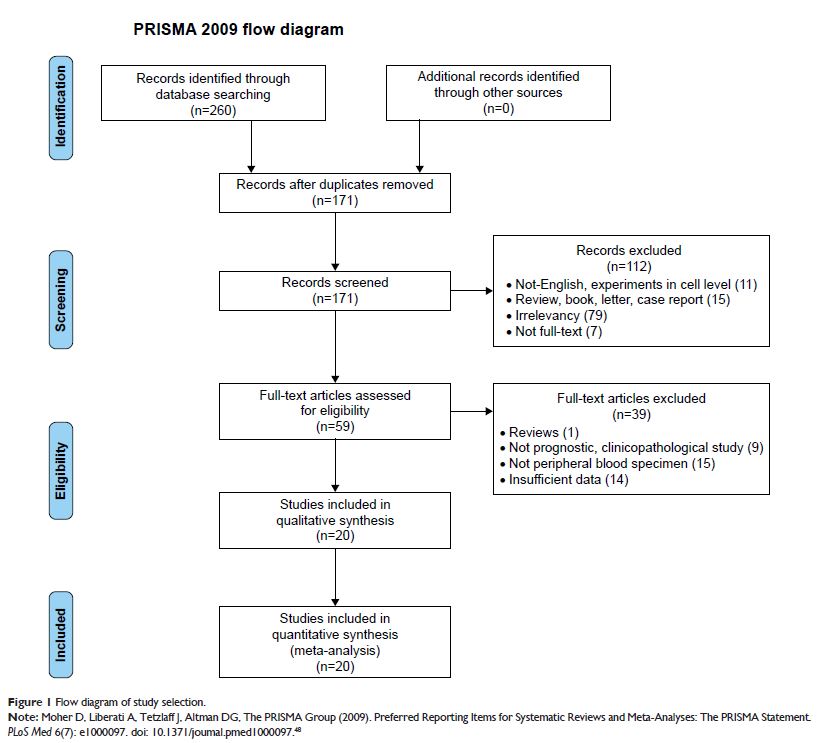108985
论文已发表
注册即可获取德孚的最新动态
IF 收录期刊
- 3.4 Breast Cancer (Dove Med Press)
- 3.2 Clin Epidemiol
- 2.6 Cancer Manag Res
- 2.9 Infect Drug Resist
- 3.7 Clin Interv Aging
- 5.1 Drug Des Dev Ther
- 3.1 Int J Chronic Obstr
- 6.6 Int J Nanomed
- 2.6 Int J Women's Health
- 2.9 Neuropsych Dis Treat
- 2.8 OncoTargets Ther
- 2.0 Patient Prefer Adher
- 2.2 Ther Clin Risk Manag
- 2.5 J Pain Res
- 3.0 Diabet Metab Synd Ob
- 3.2 Psychol Res Behav Ma
- 3.4 Nat Sci Sleep
- 1.8 Pharmgenomics Pers Med
- 2.0 Risk Manag Healthc Policy
- 4.1 J Inflamm Res
- 2.0 Int J Gen Med
- 3.4 J Hepatocell Carcinoma
- 3.0 J Asthma Allergy
- 2.2 Clin Cosmet Investig Dermatol
- 2.4 J Multidiscip Healthc

血浆乳腺球蛋白 A 表达对乳腺癌患者预后的意义:一项综合分析
Authors Hu YY, Liu P, Wu D, Jiang YH
Received 9 November 2017
Accepted for publication 26 March 2018
Published 30 May 2018 Volume 2018:11 Pages 3245—3255
DOI https://doi.org/10.2147/OTT.S156556
Checked for plagiarism Yes
Review by Single-blind
Peer reviewers approved by Dr Colin Mak
Peer reviewer comments 2
Editor who approved publication: Prof. Dr. Geoffrey Pietersz
Abstract: Mammaglobin A expression in peripheral blood (PB) of breast
carcinoma patients has been evaluated by various studies, but the findings have
been inconsistent. This meta-analysis aimed to clarify the prognostic value of
mammaglobin A in the PB of breast carcinoma patients and define its
relationships with clinicopathological features. PubMed, EMBASE, and the
Cochrane Library databases were systematically searched for eligible studies
through September 26, 2017. A total of 20 studies involving 2,323 patients were
analyzed, and the data were independently extracted by two researchers. The
combined hazard ratios (HRs) with 95% CI was used to assess the association
between survival data and plasma mammaglobin A expression, and odds ratios
(ORs) and 95% CIs were used to assess the associations between
clinicopathological parameters and plasma mammaglobin A expression. The results
indicated that plasma mammaglobin A expression was a predictor of poor
prognosis for breast carcinoma patients, with an HR of 2.08 (95%
CI=1.48–2.91; P <0.0001) for
overall survival. Moreover, plasma mammaglobin A was significantly associated
with lymph node metastasis (OR=2.00; 95% CI=1.17–3.45; P =0.01) and advanced tumor
stage (OR=3.01; 95% CI=1.57–5.77; P =0.0009) in breast
carcinoma patients. However, the results revealed that plasma mammaglobin A was
not significantly associated with tumor size (OR=1.29; 95% CI=0.46–3.66; P =0.63), tumor differentiation
(OR=0.99; 95% CI=0.63–1.57; P =0.97), menopausal
status (OR=0.75; 95% CI=0.48–1.18; P =0.22), estrogen
receptor status (OR=0.78; 95% CI=0.44–1.36; P =0.38),
progesterone receptor status (OR=0.76; 95% CI=0.57–1.02; P =0.07), or human epidermal growth
factor receptor 2 status (OR=1.12; 95% CI=0.78–1.59; P =0.54). In conclusion, the
results demonstrate that positive plasma mammaglobin A expression might serve
as a biomarker of poor prognosis for breast carcinoma patients.
Keywords: plasma mammaglobin A, breast carcinoma, prognosis, meta-analysis
